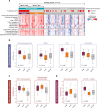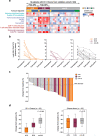Unraveling tumour microenvironment heterogeneity in nasopharyngeal carcinoma identifies biologically distinct immune subtypes predicting prognosis and immunotherapy responses
- PMID: 33430876
- PMCID: PMC7798236
- DOI: 10.1186/s12943-020-01292-5
Unraveling tumour microenvironment heterogeneity in nasopharyngeal carcinoma identifies biologically distinct immune subtypes predicting prognosis and immunotherapy responses
Abstract
Currently, there is no strong evidence of the well-established biomarkers for immune checkpoint inhibitors (ICIs) in nasopharyngeal carcinoma (NPC). Here, we aimed to reveal the heterogeneity of tumour microenvironment (TME) through virtual microdissection of gene expression profiles. An immune-enriched subtype was identified in 38% (43/113) of patients, which was characterized by significant enrichment of immune cells or immune responses. The remaining patients were therefore classified as a non-Immune Subtype (non-IS), which exhibited highly proliferative features. Then we identified a tumour immune evasion state within the immune-enriched subtype (18/43, 42%), in which high expression of exclusion- and dysfunction-related signatures was observed. These subgroups were designated the Evaded and Active Immune Subtype (E-IS and A-IS), respectively. We further demonstrated that A-IS predicted favourable survival and improved ICI response as compared to E-IS and non-IS. In summary, this study introduces the novel immune subtypes and demonstrates their feasibility in tailoring immunotherapeutic strategies.
Keywords: Gene expression profiles; Immunotherapy responses; Nasopharyngeal carcinoma; Prognosis; Tumour microenvironment; Virtual microdissection.
Conflict of interest statement
The authors declare that they have no conflicts of interest.
Figures



Similar articles
-
KMO-driven metabolic reconfiguration and its impact on immune cell infiltration in nasopharyngeal carcinoma: a new avenue for immunotherapy.Cancer Immunol Immunother. 2025 Feb 1;74(3):75. doi: 10.1007/s00262-024-03928-7. Cancer Immunol Immunother. 2025. PMID: 39891699 Free PMC article.
-
Single-cell transcriptomics reveals regulators underlying immune cell diversity and immune subtypes associated with prognosis in nasopharyngeal carcinoma.Cell Res. 2020 Nov;30(11):1024-1042. doi: 10.1038/s41422-020-0374-x. Epub 2020 Jul 20. Cell Res. 2020. PMID: 32686767 Free PMC article.
-
m6A Regulators Mediated Methylation Modification Patterns and Tumor Microenvironment Infiltration Characterization In Nasopharyngeal Carcinoma.Front Immunol. 2022 Jan 7;12:762243. doi: 10.3389/fimmu.2021.762243. eCollection 2021. Front Immunol. 2022. PMID: 35069534 Free PMC article.
-
Immunotherapeutic approaches in nasopharyngeal carcinoma.Expert Opin Biol Ther. 2019 Nov;19(11):1165-1172. doi: 10.1080/14712598.2019.1650910. Epub 2019 Aug 13. Expert Opin Biol Ther. 2019. PMID: 31361154 Review.
-
Novel Therapies Boosting T Cell Immunity in Epstein Barr Virus-Associated Nasopharyngeal Carcinoma.Int J Mol Sci. 2020 Jun 16;21(12):4292. doi: 10.3390/ijms21124292. Int J Mol Sci. 2020. PMID: 32560253 Free PMC article. Review.
Cited by
-
Whole-Exome Sequencing Reveals the Genomic Features of the Micropapillary Component in Ground-Glass Opacities.Cancers (Basel). 2022 Aug 27;14(17):4165. doi: 10.3390/cancers14174165. Cancers (Basel). 2022. PMID: 36077702 Free PMC article.
-
m6A methylation: a process reshaping the tumour immune microenvironment and regulating immune evasion.Mol Cancer. 2023 Mar 1;22(1):42. doi: 10.1186/s12943-022-01704-8. Mol Cancer. 2023. PMID: 36859310 Free PMC article. Review.
-
Multimodality Management of EBV-Associated Nasopharyngeal Carcinoma.Cancers (Basel). 2021 Dec 2;13(23):6078. doi: 10.3390/cancers13236078. Cancers (Basel). 2021. PMID: 34885187 Free PMC article. Review.
-
Identification of novel molecular subtypes to improve the classification framework of nasopharyngeal carcinoma.Br J Cancer. 2024 Apr;130(7):1176-1186. doi: 10.1038/s41416-024-02579-w. Epub 2024 Jan 27. Br J Cancer. 2024. PMID: 38280969 Free PMC article.
-
An Integrative Analysis of Nasopharyngeal Carcinoma Genomes Unraveled Unique Processes Driving a Viral-Positive Cancer.Cancers (Basel). 2023 Feb 15;15(4):1243. doi: 10.3390/cancers15041243. Cancers (Basel). 2023. PMID: 36831585 Free PMC article.
References
Publication types
MeSH terms
LinkOut - more resources
Full Text Sources
Other Literature Sources

